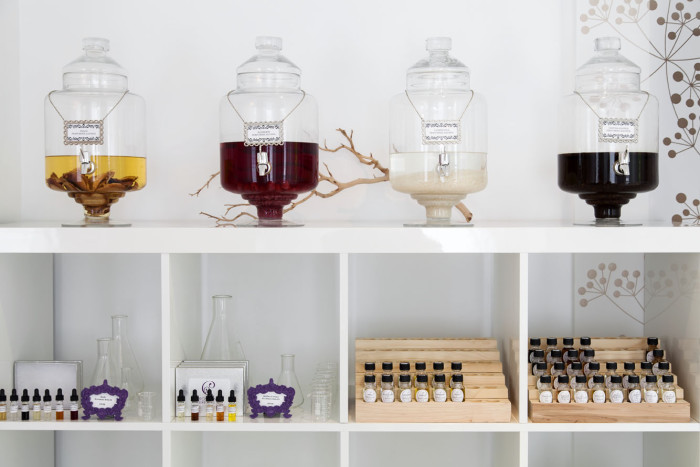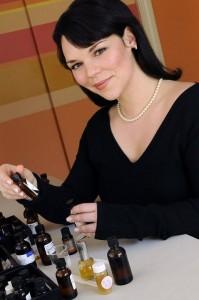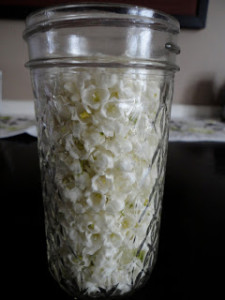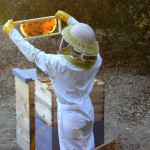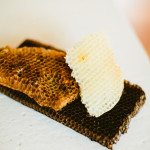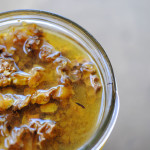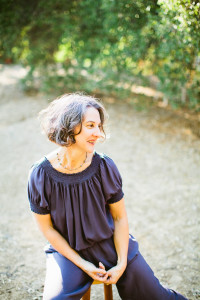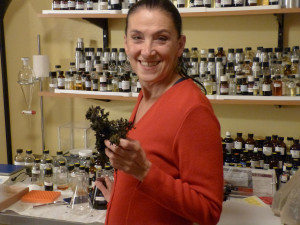"Raspberry, Peach, Jasmine Rice and Vanilla Tinctures at Providence Perfume Co Boutique, Rhode island
What’s on the perfumer’s palette today? With growing accessibility to a diminishing supply of natural essences there is a Catch-22 phenomenon impacting the production of fragrances rooted in nature. The horrific work-around can be witnessed in the fragrance industry’s synthetic reconstruction and reinvention of what is beautiful and what is natural for today’s urban consumer who has never taken the time to smell the real deal. The trend amongst Indie perfumers to reconnect to botanical essences is part of the resurgence of back-to-basics, we need to honor and make sustainable our planet and be one with nature.
Natural essences are created in many ways, using heat, chemical extraction and CO2 distillation being most common, but old-fashioned tincturing, throwing some herbs, resins, woods or flowers in with a batch of very strong alcohol is one of the most primeval yet currently popular forms of creating fragrance notes. It’s a bit of a crap shoot and great test of patience and devotion but modern perfumers are using tinctures to capture a really full olfactory profile of materials that lend themselves to this method. These essences can be so pure and life-like that they remind us of olfactory eidetics, perfect snapshots of the energetic imprint of the original natural material.
We spoke to three luminous perfumers, Charna Ethier of Providence Perfumes, Roxana Villa of Roxana Illuminated Perfume and Ellen Covey of Olympic Orchids to find out what’s in their tincture pots and how they are making perfumes with these tinctures. All three are tincturing materials that are close to their homes and their heart while trying more offbeat possibilities as well in search of olfactory paydirt.
Charna Ethier of Providence Perfume Co.
Let’s start with Charna and her cream-on-cream Moss Gown perfume. So rich it is hard to pry open but inside the floral heart is a tincture of lilies, growing abundant in her New England locale, which took her two years to collect and make strong enough to create fragrant impact. Dry materials tincture best, like a vanilla bean is the perfect item to tincture, but wet materials like florals yield but the tiniest trace of their essence and the flowers must be swapped out on a daily basis for the eidetic process to take root. We are basically hunter-gatherers and Charna fulfilled our fundamental human role with love and devotion.
Muguet tincture (lily of the valley)
Charna also uses sugars and starches in a unique fashion to pre-tincture her base alcohol. She finds that these infused alcohols have the ability to increase the longevity or “fix” a fragrance while also adding a subliminal note throughout the life cycle of the scent. Rice-based infusions add a lactonic quality to perfumes while she has found that pre-fixing a scent with various fruits will carry that fruit note throughout the fragrance from top to bottom. We found her work to be extremely vital without the use of traditional fixatives.
Roxana Villa of Roxana Illuminated All Natural Perfume is a holistic beekeeper; Preparing honeycomb for tincturing
Roxana Villa’s To Bee is an attention getter. We all know that bees are confused these days and Roxana is deeply involved in rescuing feral bees in the Los Angeles area. She began tincturing feral bee comb and found “that after three months of melding, the tincture had the distinct aroma of a thriving feral hive.” The scent captures a far deeper spectrum than honey or beeswax absolute could ever offer. It smells busy in there, heathery and resonant. Modern tincturing can be like a fragrance time capsule and perhaps someday we will have the means to capture these natural essences forever, but today we live with the evanescent nature of nature. (Editor's Note: For a fascinating look into Roxana's To Bee project and more about holistic beekeeping click here)
Roxana Villa
Social consciousness informs all Roxana’s work starting with her first fragrance “Q” which is built on a tincture of oak leaves, as this grand tree of the American past is being replaced by palm trees in her surroundings.
Ellen Covey, perfumer for Olympic Orchids preparing a seaweed tincture
Ellen Covey is a tincturer after our own heart. She’ll try anything including soy sauce and sesame oil. Her Devil Scent series uses tinctured myrrh and she muses, “A good tincture of myrrh is powerfully aromatic without the industrial-oil notes one gets in the distilled oil.” We loved it and were ready to throw out our essential oil/absolute blend of myrrh for this stuff that really smells like…you guessed it, real myrrh. There’s a damp earth smell to this one that Ellen surmises comes from the black truffle fungus tincture that also inhabits this Luciferian brew. The seaweed tincture in Ellen’s Kingston Ferry perfume is close to our own heart as we also live near this ferry. Ellen says she loves the smell of seaweed because it reminds her of the algae-like smell of swimming in a pond.
Perception is very personal, we get a different vibe from the seaweed than the perfumer does but by using high quality tinctures perfumers share with us a very close proximity to the original scent profile of the natural material. They also bring us into their lives, their passions and their surroundings. Perfumers have found subtler ways to put the chemistry of tinctures to work in enhancing and expanding the olfactory experience. At a crossroads where ersatz food, sim cards and social media scream for our full devotion, perfumers are getting real and reminding us that we too can embrace our primeval sense of scent and better embrace our place in the world.
–David Falsberg, Guest Contributor and Perfumer for Phoenicia Perfumes
Editor's Note: David, Charna, Roxana and Ellen have taken part in our CaFleureBon Profiles in American Perfumery Series which features many of the country's most innovative indie perfumers
Thanks to our three luminous ladies, Charna, Roxana and Ellen we have one artisan perfume set containing Moss Gown 100 percent Natural Perfume, To BeeOrganic Perfume and Kingston Ferry for one of our U.S. Reader. To be eligible please leave a comment with what you learned about tincturing with natural essences by October 14, 2013.
Please support American Perfumery and LIKE CaFleureBon Profiles in American Perfumery on Facebook
We announce the winners on our site and on our Facebook Page Like Cafleurebon and use our RSS option…or your dream prize wil be just spilled perfume

